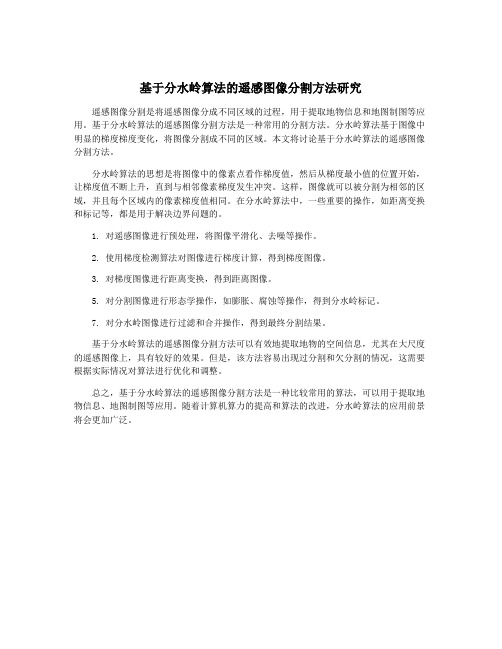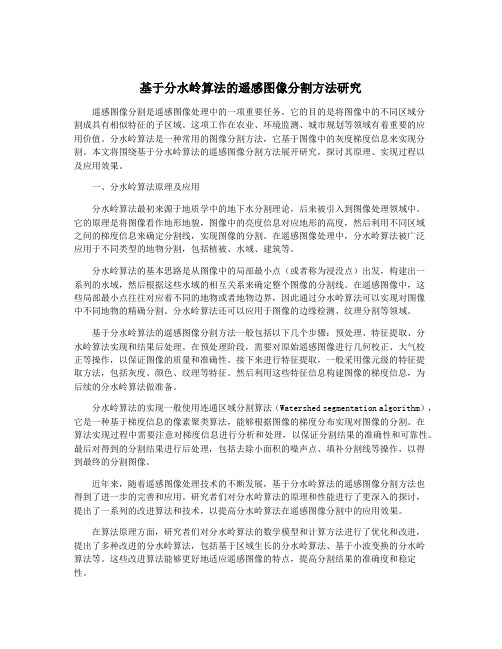基于Contourlet变换和分水岭分割的红外图像分割研究
基于分水岭算法的遥感图像分割方法研究

基于分水岭算法的遥感图像分割方法研究
遥感图像分割是将遥感图像分成不同区域的过程,用于提取地物信息和地图制图等应用。
基于分水岭算法的遥感图像分割方法是一种常用的分割方法。
分水岭算法基于图像中明显的梯度梯度变化,将图像分割成不同的区域。
本文将讨论基于分水岭算法的遥感图像分割方法。
分水岭算法的思想是将图像中的像素点看作梯度值,然后从梯度最小值的位置开始,让梯度值不断上升,直到与相邻像素梯度发生冲突。
这样,图像就可以被分割为相邻的区域,并且每个区域内的像素梯度值相同。
在分水岭算法中,一些重要的操作,如距离变换和标记等,都是用于解决边界问题的。
1. 对遥感图像进行预处理,将图像平滑化、去噪等操作。
2. 使用梯度检测算法对图像进行梯度计算,得到梯度图像。
3. 对梯度图像进行距离变换,得到距离图像。
5. 对分割图像进行形态学操作,如膨胀、腐蚀等操作,得到分水岭标记。
7. 对分水岭图像进行过滤和合并操作,得到最终分割结果。
基于分水岭算法的遥感图像分割方法可以有效地提取地物的空间信息,尤其在大尺度的遥感图像上,具有较好的效果。
但是,该方法容易出现过分割和欠分割的情况,这需要根据实际情况对算法进行优化和调整。
总之,基于分水岭算法的遥感图像分割方法是一种比较常用的算法,可以用于提取地物信息、地图制图等应用。
随着计算机算力的提高和算法的改进,分水岭算法的应用前景将会更加广泛。
基于Contourlet变换和模糊理论的红外图像增强算法

( c o l f n r t n a dE e t nc , e i s tt o e h o g , e ig1 0 8 , hn ) S h o o f ma o n l r is B in I tue f c n l y B i n 0 0 1 C ia Io i co jg n i T o j
C n o r tt n fr sp r r d o h rgn li f r d i g w a b a n lw— a s s b a d a d b n ・ a s s b o tu l r so e a m i e ome n t e o ia n r e ma e, e c n o ti o p s u b n n a d p s u — f i a
与模 糊理 论 的红外 图像增 强算 法。 首先对 图像进 行 C n ul 变换 , 到 多尺 度 多方 向的低 通 ot r t o e 得 子 带和 带通子 带。对低 通 子带 , 行基 于子 带 系数最 大最小值 的线性 变换 , 高 图像 的整体对 进 提
比度 ; 于 带通 子 带 , 对 先估 计 噪 声 阈值 , 子 带 系数进 行 抑 制 噪声 处理 , 对 然后 通 过模 糊 增 强算
・ 红外技 术 ・
基 于 C nor t 换 和模 糊 理 论 的红外 图像 增 强算 法 ot l 变 ue
彭 洲 , 保 军 赵
( 北京理工大学信息与电子学院 , 北京 10 8 ) 00 1
摘
要 : 外 图像具 有 噪声大 、 比度 低 等特 点 , 对 该 特 点 , 出 了一种 基 于 C no r t 红 对 针 提 o t l 变换 ue
基于Contourlet变换的红外图像去噪技术

基于Contourlet变换的红外图像去噪技术
周欣;林玉池;宋;乐;黄银国
【期刊名称】《传感器与微系统》
【年(卷),期】2008(027)003
【摘要】研究了一种基于Contourlet变换的红外图像去噪技术.在Contourlet域中使用硬阈值函数对Con-tourlet变换后的系数进行处理,经反变换即可得到较好的去噪图像.实验结果表明:与传统的小波阈值去噪方法相比,该方法能够更有效地保留红外图像的细节和纹理,具有更好的视觉效果和较优的信噪比.
【总页数】3页(P37-38,42)
【作者】周欣;林玉池;宋;乐;黄银国
【作者单位】天津大学精密测试技术及仪器国家重点实验室,天津,300072;天津大学精密测试技术及仪器国家重点实验室,天津,300072;天津大学精密测试技术及仪器国家重点实验室,天津,300072;天津大学精密测试技术及仪器国家重点实验室,天津,300072;天津大学精密测试技术及仪器国家重点实验室,天津,300072
【正文语种】中文
【中图分类】TP751
【相关文献】
1.基于贝叶斯双变量模型和Contourlet变换相结合的红外图像去噪 [J], 杭丹萍;梁栋;马雪亮;韦卫东;唐王琴;徐慧
2.基于Contourlet变换的红外图像序列小目标检测技术 [J], 罗子娟;吴一全
3.基于稀疏编码收缩和Contourlet变换的红外图像去噪 [J], 陈盛双;张富铭;王传廷;赵鹏
4.基于Contourlet变换的红外视频监控图像去噪算法研究 [J], 王博;张成;车进
5.基于改进邻域收缩法的非下采样Contourlet变换域红外图像去噪 [J], 齐乃新;曹立佳;杨小冈;陈世伟
因版权原因,仅展示原文概要,查看原文内容请购买。
一种基于非采样Contourlet变换红外图像与可见光图像融合算法

一种基于非采样Contourlet变换红外图像与可见光图像融合算法张强;郭宝龙【期刊名称】《红外与毫米波学报》【年(卷),期】2007(26)6【摘要】针对同一场景红外图像与可见光图像的融合问题,提出了一种基于非采样Contourlet变换(Nonsubsampled Contourlet Transform,NSCT)图像融合算法.算法首先采用NSCT对源图像进行多尺度、多方向分解,得到低频子带系数和各带通方向子带系数.然后,针对低频子带系数的选择,提出了一种基于红外图像与可见光图像物理特征的"加权平均"系数选择方案;针对各带通方向子带系数的选择,结合人眼视觉特性,提出了一种基于区域能量匹配的系数选择方案,得到融合图像的NSCT 系数.最后经过NSCT逆变换得到融合图像.实验结果表明该算法可获得较理想的融合图像,其融合效果优于传统的基于离散小波变换以及离散小波框架变换的图像融合算法.【总页数】5页(P476-480)【作者】张强;郭宝龙【作者单位】西安电子科技大学机电工程学院,智能控制与图像工程研究所,陕西,西安,710071;西安电子科技大学机电工程学院,智能控制与图像工程研究所,陕西,西安,710071【正文语种】中文【中图分类】TP391【相关文献】1.一种基于非采样Contourlet变换的图像融合算法 [J], 李美丽;王红梅;李言俊;张科2.基于区域分割和非采样Contourlet变换的红外和可见光图像融合 [J], 杨粤涛;朱明;贺柏根;高文3.基于非采样Contourlet变换的红外与可见光图像融合方法 [J], 柴奇;杨华;杨伟4.一种基于非采样Contourlet变换的图像融合算法 [J], 黄克宇;李敏;何玉杰;梁婷5.基于非抽样Contourlet变换的红外图像和可见光图像融合算法 [J], 何国栋;梁栋;姚红;夏颖;李新华因版权原因,仅展示原文概要,查看原文内容请购买。
基于分水岭算法的遥感图像分割方法研究

基于分水岭算法的遥感图像分割方法研究遥感图像分割是遥感图像处理中的一项重要任务,它的目的是将图像中的不同区域分割成具有相似特征的子区域。
这项工作在农业、环境监测、城市规划等领域有着重要的应用价值。
分水岭算法是一种常用的图像分割方法,它基于图像中的灰度梯度信息来实现分割。
本文将围绕基于分水岭算法的遥感图像分割方法展开研究,探讨其原理、实现过程以及应用效果。
一、分水岭算法原理及应用分水岭算法最初来源于地质学中的地下水分割理论,后来被引入到图像处理领域中。
它的原理是将图像看作地形地貌,图像中的亮度信息对应地形的高度,然后利用不同区域之间的梯度信息来确定分割线,实现图像的分割。
在遥感图像处理中,分水岭算法被广泛应用于不同类型的地物分割,包括植被、水域、建筑等。
分水岭算法的基本思路是从图像中的局部最小点(或者称为浸没点)出发,构建出一系列的水域,然后根据这些水域的相互关系来确定整个图像的分割线。
在遥感图像中,这些局部最小点往往对应着不同的地物或者地物边界,因此通过分水岭算法可以实现对图像中不同地物的精确分割。
分水岭算法还可以应用于图像的边缘检测、纹理分割等领域。
基于分水岭算法的遥感图像分割方法一般包括以下几个步骤:预处理、特征提取、分水岭算法实现和结果后处理。
在预处理阶段,需要对原始遥感图像进行几何校正、大气校正等操作,以保证图像的质量和准确性。
接下来进行特征提取,一般采用像元级的特征提取方法,包括灰度、颜色、纹理等特征。
然后利用这些特征信息构建图像的梯度信息,为后续的分水岭算法做准备。
分水岭算法的实现一般使用连通区域分割算法(Watershed segmentation algorithm),它是一种基于梯度信息的像素聚类算法,能够根据图像的梯度分布实现对图像的分割。
在算法实现过程中需要注意对梯度信息进行分析和处理,以保证分割结果的准确性和可靠性。
最后对得到的分割结果进行后处理,包括去除小面积的噪声点、填补分割线等操作,以得到最终的分割图像。
Contourlet变换在可见光与红外图像融合中的应用

<div class="article_tit"> Contourlet变换在可见光与红外图像融合中的应用</div> <span>作者 : 李喆赵昊</span> <p> 摘要:Contourle变换是一种新的图像多尺度,多方向的表示方法,适合表达具有丰富细节信息及方向信息的图像。
它的高频方向子带,捕获了许多传感器图像的显著特征。
为了实现红外与可见光图像的融合,采用一种基于Contourlet变换的融合算法,对不同的融合规则对低频子带和多方向的高频子带系数进行融合。
对比实验结果表明,在此提出的方法可以获得较好的融合效果,优于基于小波变换的图像融合算法。
<br/> 关键词:图像融合; Contourlet 变换;红外;可见光 <br/> 中图分类号:TN919-34 文献标识码:A 文章编号:1004-373X(2011)24-0093-03 <br/> <br/> <br/> Application of Contourlet Transform in Visible and Iinfrared Images Fusion <br/> <br/> LI Zhe, ZHAO Hao <br/> <br/> (Nanjing University of Aeronautics and Astronautics, Nanjing 210016, China) <br/> <br/> Abstract: The Contourlet transform is a new image multiscale and multi-direction representation suitable for expressing the images with rich detail information and direction information. An infrared and visible image fusion algorithm based on the Contourlet transform is adopted to fuse the low frequency subband coefficients and the high frequency subband coefficients in all directions by suitable fusion rules. The fusion images are reconstructed by using the fusion coefficients. The experimental results show that this algorithm proposed above can get better fusion results than that of wavelet tranform image fusion. <br/> Keywords: image fusion; Contourlet transform; infrared image; visible image <br/> <br/> 收稿日期:2011-08-07 <br/> 基金项目:国家大学生创新性实验计划基金资助项目 <br/> (101028713) <br/> 0 引言 <br/> 图像融合是指将来自不同传感器的同一目标或同一场景的多幅图像进行综合,得到更为准确、可靠、全面的图像描述的处理过程,属于信息融合范畴。
基于分水岭算法的遥感图像分割方法研究

基于分水岭算法的遥感图像分割方法研究【摘要】本文研究了基于分水岭算法的遥感图像分割方法。
首先介绍了分水岭算法的原理,然后对遥感图像分割技术进行了综述。
接着详细探讨了基于分水岭算法的遥感图像分割方法,并设计了相应的实验进行结果分析。
进一步对算法进行了优化和改进。
在讨论了分水岭算法在遥感图像分割中的应用,总结了研究成果,并展望了未来的研究方向。
通过本研究,提出了基于分水岭算法的遥感图像分割方法在实际应用中的潜力和局限性,为遥感图像处理领域的进一步研究提供了有益参考。
【关键词】遥感图像分割、分水岭算法、遥感图像处理、图像分割技术、实验设计、结果分析、算法优化、研究成果、未来展望1. 引言1.1 研究背景遥感图像分割作为遥感图像处理中的重要技术,对于地质勘探、环境保护、农业监测等领域具有重要的应用价值。
传统的遥感图像分割方法存在着受到影响较大的噪声、复杂纹理、光照变化等问题,导致分割结果的准确性和稳定性难以保证。
如何提高遥感图像分割的准确性和效率成为了当前研究的热点之一。
本研究旨在探讨基于分水岭算法的遥感图像分割方法,通过对算法原理、技术综述以及实验设计与结果分析等方面的研究,旨在提高遥感图像分割的准确性和效率,为遥感图像分割技术的进一步发展提供参考和借鉴。
1.2 研究意义遥感图像分割是遥感领域中的重要研究方向,其在农业、城市规划、环境监测等领域具有广泛的应用前景。
研究基于分水岭算法的遥感图像分割方法具有很大的意义。
随着遥感技术的不断发展,遥感图像的分辨率和数据量不断增加,传统的图像分割方法已经难以满足高效、准确的需求。
基于分水岭算法的遥感图像分割方法可以有效地处理高分辨率遥感图像,提高分割的准确性和效率。
基于分水岭算法的遥感图像分割方法在实际应用中具有较强的鲁棒性,能够有效克服遥感图像中存在的噪声、阴影等问题,提高分割结果的质量。
该方法还能够根据目标物体的特征进行分割,从而实现对复杂场景的精确识别与分割。
基于Contourlet变换的红外弱小目标检测新方法

基于Contourlet变换的红外弱小目标检测新方法吴文怡1,吴一全 2(1南京航空航天大学信息科学与技术学院;江苏南京;210016;2 南京航空航天大学信息科学与技术学院;江苏南京;210016)摘要:本文研究存在背景干扰和噪声情况下的红外图像中弱小运动目标的检测问题,提出了一种基于Contourlet变换的红外弱小目标检测算法。
首先对图像进行Contourlet变换,利用Contourlet分解后子图像的特性抑制背景和去除噪声,实现目标的最终检测。
通过实验在含有随机目标的红外序列图像中的应用,并与小波变换进行比较,证明了算法的有效性。
关键词:红外弱小目标;Contourlet变换;抑制背景;去噪声A New Method of Infrared Dim Targets DetectionBased on Contourlet TransformWu Wenyi1, Wu Yiquan2(1 College of Information Science and Technology, Nanjing University of Aeronautics and Astronautics; Nanjing China;210016;2. College of Information Science and Technology, Nanjing University of Aeronautics and Astronautics; Nanjing China;210016)Abstract: The problem of detecting dim moving targets in infrared image sequences that also contain moving nuisance objects and background noise is addressed in this paper.A new dim target detection approach based on contourlet transformation is put forward.According to the features of the decomposing images after contourlet transform, the background clutter and noise is eliminated and the final detecting of the target is realized. Comparing to wavelet transformation, the effectiveness of this new method is demonstrated by applying the resulting algorithm to infrared images containing targets of opportunity.Key words: infrared dim target;contourlet transform;background suppression;noise eliminate引言为了尽可能早地发现目标,使武器系统有足够的反应时间,要求目标在很远处就能被检测到,此时目标的成像面积往往只有一个或几个像素。
- 1、下载文档前请自行甄别文档内容的完整性,平台不提供额外的编辑、内容补充、找答案等附加服务。
- 2、"仅部分预览"的文档,不可在线预览部分如存在完整性等问题,可反馈申请退款(可完整预览的文档不适用该条件!)。
- 3、如文档侵犯您的权益,请联系客服反馈,我们会尽快为您处理(人工客服工作时间:9:00-18:30)。
I
I. INTRODUCTION
the image. In the recognition process of the image processing, the most fundamental and most difficult aspect is segmentation. Only after good segmentation, the targets can be separated and classed well. Image segmentation is progress of divide the image into a number of parts based on certain criteria, and extracts the regions and goals which we are interested in. In this paper, we use sharp frequency localize contourlet transform and morphology method for denoising the mixture noise, background suppression and enhancement goals. By selecting the appropriate structural elements of the image, extract goals by morphology watershed method. From the experiments, we can find that, the new method gets the ideal result. We introduce the general progress and method of image segmentation in Section I. In Section II, we briefly introduce sharp frequency localization contourlet transform and morphology watershed method. As a solution, we propose in Section III a new method in image segmentation. Vision experiments are presented in Section IV. We conclude the paper in Section V. II. SHARP FREQUECY LOCALIZATION CONTOURLET AND MORPHOLOGY METHODS A. Sharp Frequency Localization Contourlet The original contourlet is constructed by the combination of Laplacian pyramid [1]. We can see that the Laplacian pyramid shown in the diagram is a simplified version of its actual implementation as shown in Fig. 1. However, the frequency division in Fig. 1(b) is obtained by ideal filters. When non-ideal filters are combined with Laplacian pyramid, we show a more realistic illustration of one of the directional filters [2] from the direction filter banks in Fig. 2(a). If the directional filter must first be upsampled by 2 along each dimensions, which as shown in Fig. 2(b). Because of the upsampling, the aliasing components are folded towards the lowpass regions and concentrated mostly along two lines ω2=±π/2. Combining the upsampled DFB was shown in Fig. 2(c). In Fig. 2(d), we can see the resulting contourlet subband. In order to solve this problem, Yue M. LU proposed a new construction of a sharp frequency localization contourlet transform (SFLCT) [3]. Instead of using the Laplacian pyramid, he employed a new pyramid structure for multiscale decomposition, which is shown in Fig. 3. The difference between SFLCT and contourlet transform is that, SFLCT use the new multiscale pyramid and can employ a different set of lowpass and highpass filters for the levels.
Manuscript received May 10, 2010. This work was supported in part by the Jiangsu Province Nature Science Research Plan Projects for Colleges and Universities (grant No. 08KJD120002) and Open fund Project of Jiangsu Province Key Labcation (No. ZK206008). Huimin Lu is with the Kyushu Institute of Technology, Kitakyushu, 804-8550 Japan and Yangzhou University, Yangzhou, 225-009 China (phone: +81-80-4278-5999; fax: +81-93-884-3203; e-mail: yzulhm@ ). Lifeng Zhang is with the Kyushu Institute of Technology, Kitakyushu, 804-8550 Japan. He is now with the Department of Electrical Engineering and Electronics. (phone: +81-93-884-3272; fax: +81-93-884-3202; e-mail: zhang@ elcs.kyutech.ac.jp). Min Zhang is with School of Information Engineering, Yangzhou University, Yangzhou, 225-009 China. Xuelong Hu was with Yangzhou University, Yangzhou, 225-009 China. He is now with the School of Information Engineering (e-mail: huxuelong@). Seiichi Serikawa is with the Department of Electrical Engineering and Electronics, Kyushu Institute of Technology,Kitakyushu 804-8550 Japan. (e-mail: serikawa@elcs.kyutech.ac.jp).
International Conference on Intelligent Control and Information Processing August 13-15, 2010 - Dalian, China
A Method for Infrared Image Segment based on Sharp Frequency Localized Contourlet Transform and Morphology
Huimin Lu, Lifeng Zhang, Min Zhang, Xuelong Hu, and Seiichi Serikawa
Abstract—A method associating sharp frequency localized contourlet transform with morphology to remove mixing noise and suppress background disturbance of infrared images is proposed. This method use sharp frequency localized contourlet transform and a morphology filter to deny the noise in infrared images. And then segment infrared images by regional method of morphology watershed, the target can be isolated easily. During the experiments, we can see that, the submit method can detect and segment the goal in the low SNR infrared image with complicated background effectively. And the result of this method is better than that based on contourlet transform and wavelet transform.
